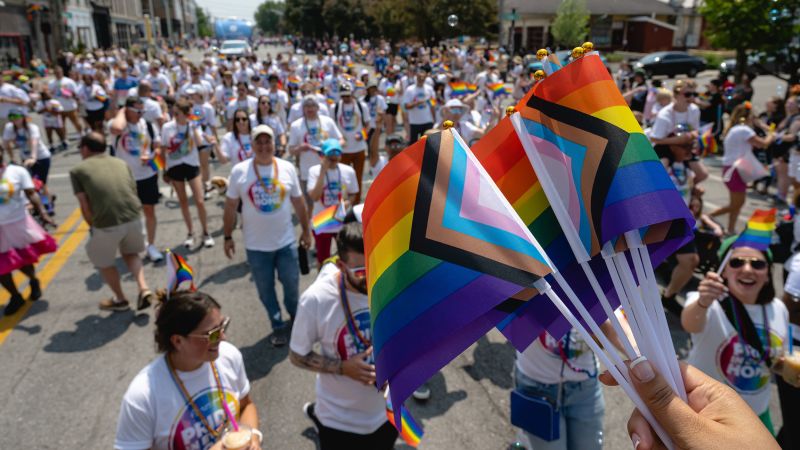
While the banking sector is shifting to better address customer needs, LGBTQ customers still often face systemic barriers in banking.
If you’re searching for a financial institution that more closely aligns with your values, here’s how to find the that support LGBTQ folks.
What makes a bank LGBTQ-friendly?
Inclusive policies and non-discrimination practices
Research from the found that two in five LGBTQ adults felt blocked or discouraged from getting financial services and products because of barriers or discrimination in how these services were designed. Furthermore, respondents who identified themselves as transgender were more than twice as likely to say they’ve experienced discrimination and bias in the financial system than LGBTQ cisgender men and women.
Aspiring experience discrimination in mortgage lending. According to a 2023 research report conducted by the, homeownership rates for LGBTQ people are significantly lower than for straight and cisgender people.
The process of changing the name on your debit card or to reflect your chosen name can also be challenging. Only a few financial institutions allow you to customize debit cards or credit cards, regardless of what your legal ID says.
Because of all of this, it’s important that banks have inclusive policies in place for LGBTQ customers. It’s also important that they have non-discrimination policies in place to keep LGBTQ customers from being discriminated against, and that they have their employees go through non-discrimination training to make sure they’re well-equipped to understand the specific needs of LGBTQ clients.
Support for LGBTQ causes and community engagement
Many banks will show their support for the LGBTQ community through donating to LGBTQ causes and partnering with LGBTQ organizations. For example, a bank might donate to an LGBTQ charity, host a charity event with a non-profit designed to help LGBTQ individuals, or otherwise engage with the community.
While this can be a sign that a bank is LGBTQ-friendly, you’ll also want to check what banks have done for their customers and workers to make sure your banking experience with them will be smooth. You’ll want to see what else they do with their money, just in case the bank is also donating to anti-LGBTQ causes.
Researching banks
Reviewing bank policies and commitments to diversity
There are a few things to look out for on a bank’s website when researching whether they are LGBTQ-friendly. First, you can see if they have a “commitment to diversity” statement or something similar that addresses diversity and inclusion in banking. If they do, you’ll want to check and see if LGBTQ people are mentioned in the statement, and whether the statement lists concrete actions the bank has taken to help their workers, their customers, and their communities.
You’ll also want to see if the bank’s policies are LGBTQ-friendly. For example, it’s important that the bank’s workers are trained to understand what LGBTQ customers need. “Making things gender neutral and not assuming that everyone is in a heteronormative relationship when it comes to dealing with banking, that’s the baseline” of what banks should do when working with LGBTQ customers, says Leo Aquino, independent journalist and finance coach at .
Seeking feedback from the LGBTQ community
While researching a bank’s website can tell you a lot about their policies and history working with LGBTQ people, it doesn’t tell you what it’s like to bank day-to-day with a company. Frequently, talking to individual LGBTQ people is a better way to get a sense of that. “Asking people around you is really the best way to learn about how certain banks or certain organizations treat LGBTQ people,” says Brian Thompson, CFP, founder of .
By talking with other LGBTQ people who have banked with your chosen institution, you can find out if they’ve ever been denied services, misgendered, or had bad experiences with banks.
Evaluating bank services and products
Checking for targeted services and products
A few banks offer services and products directly targeted towards the LGBTQ community. The most common of those are services that let you bank with your chosen name instead of your legal one, although some banks offer other services, as well. Here are a few banks that offer such services, and what they are:
- Amalgamated Bank is a socially responsible bank with open branches in Washington, DC, and the New York City area. It also offers online-only checking and savings accounts if you don’t live in these places. Amalgamated Bank showed support for LGBTQ rights by joining amicus briefs that opposed LGBTQ+ discrimination. It also allows transgender people living in New York to open bank accounts with their chosen name through IDNYC.
- If you get a BMO credit card, debit card, or ATM card, you are allowed to display your chosen name if it isn’t the same as your legal name.
- You may get a Citi credit card or debit card with your chosen name. You can call customer support to get your chosen name written on your card.
- Republic Bank: Republic Bank is a brick-and-mortar financial institution with branches in Kentucky, Indiana, Tennessee, Florida, and Ohio. Republic Bank offers the True Name feature for its debit cards, although the name on your will still be your legal name.
- Climate First Bank: Climate First Bank is a Florida bank that offers online banking products, such as CDs and . One of the accounts it offers is Pride Banking, a checking account with perks designed for the LGBTQ community. With Pride Banking, you can bank with your preferred name and pronouns, and Climate First Bank will donate to a local charity that helps people get access to healthcare like PrEP in Florida for every new Pride Banking account that meets certain requirements.
- Element Federal Credit Union: Element Federal Credit Union is a for West Virginia residents that allows you to bank with your correct name and pronouns. It also makes donations to local LGBTQ community organizations when you meet certain criteria.
Accessibility of services for LGBTQ individuals
One thing to check is whether all of the services the bank offers are equally available to LGBTQ customers as to straight, cisgender customers. “If you are not married, it makes it a little bit harder to have and function together,” says Thompson.
He says that, if you do have a long-term unmarried partner, ask the bank ahead of time whether it has any additional rules that unmarried couples have to meet before getting service.
Also consider the general accessibility of a bank; if a bank is not accessible to disabled customers (for example, if the bank’s website is not screen reader compatible), or if a bank has a history of discriminating against its customers of color, then it’s not truly accessible for the entire LGBTQ+ community.
Community and advocacy support
Banks’ involvement in LGBTQ advocacy and support groups
One way that many banks show LGBTQ community banking support is through pride, whether through sponsoring pride events or having a float in a local pride. However, sometimes this can come off as “rainbow capitalism,” a term that refers to companies providing superficial support of LGBTQ causes as a way to gain more customers.
Thompson says that, in order to check whether a bank’s support is more substantial, it might be worthwhile to check what they do outside of pride month. “Making sure that it’s not just a June issue where you’re advertising towards LGBTQ people, but offering something throughout the year.”
Partnerships with LGBTQ-friendly businesses and organizations
One way to evaluate banks for LGBTQ inclusivity is to check if it’s partnered with LGBTQ+ businesses and organizations. Check to see how it helps the organizations it’s partnered with, and what the result of those partnerships are.
Questions to ask
As part of your research on whether a bank meets your inclusive banking criteria, you may want to actually call or walk into a bank to ask questions. In that case, you’ll want to bring up specific questions about their policies or services that are relevant to your situation. “For trans folk specifically, one of the simpler ones is ‘I’ve had a gender affirming name change. Do you know what that means?'” says Aquino.
Specific questions are frequently easier for customer service to answer, and you’re more likely to get the information you need with them.
Online resources and tools
Websites for comparing LGBTQ-friendly banking options
There are a few different places where you can find information on LGBTQ-friendly banks. Thompson says it could be useful to check the , which provides the LGBTBE certification for LGBTQ-owned businesses. It also works with affiliated state-specific chambers of commerce, which often have lists of local LGBTQ businesses. An example of this is the . Check to see if your local affiliated chamber of commerce has a list of LGBTQ businesses that includes a bank for.
Another place to check is the Human Rights Campaign’s . But keep in mind that you aren’t going to find local or small businesses there. “The companies that appear there are like JP Morgan Chase, or Bank of America,” says Aquino. “These are the folks that have the resources to buy LGBTQ 101 kinds of training.”
If you’re looking for a smaller, local bank, you’re better off checking with your local LGBT Chamber of Commerce affiliate, doing a google search for LGBTQ-friendly banks in your area, or asking other LGBTQ people for their preferences.
Social media and forums for community recommendations
If you’re looking for honest reviews of banks’ advocacy and financial services from actual LGBTQ people online, social media might be the way to go. Aquino says that Reddit frequently has authentic reviews from LGBTQ people who have actually used the bank. He says that searching “trans+ [name of bank] from:reddit.com” helps them find reviews from actual trans people who have used the services he’s interested in.
LGBTQ-friendly banking FAQs
How can I tell if a bank is genuinely LGBTQ-friendly?
You can tell if a bank is genuinely LGBTQ-friendly by looking at the actions that a bank has taken. Check if a bank has diversity training for employees, partnerships with LGBTQ organizations, and transparent policies protecting against discrimination.
Are there any certifications or endorsements to look out for?
The LGBTBE certification by the National LGBT Chamber of Commerce certifies that a company is LGBTQ-owned, and could be helpful if you’re looking for LGBTQ-owned banks. The Human Rights Campaign’s Equality 100 award could also be useful if you’re looking for a big bank with LGBTQ-friendly policies.
Can switching to an LGBTQ-friendly bank make a difference?
Yes, switching to an LGBTQ-friendly bank can help LGBTQ customers receive better, more tailored service while potentially supporting causes they believe in.
How do LGBTQ-friendly banks support the community?
Many LGBTQ-friendly banks may give to LGBTQ causes, sponsor Pride events, and have financial services tailored to the needs of LGBTQ individuals. LGBTQ-friendly banks also ensure their practices reflect a commitment to equality and diversity.
What if there are no explicitly LGBTQ-friendly banks in my area?
You can find online banking options. These institutions can often provide an inclusive banking experience regardless of where you live.



